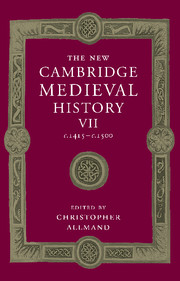Book contents
- Frontmatter
- PART I GOVERNMENT
- PART II ECONOMIC AND SOCIAL DEVELOPMENTS
- PART III SPIRITUAL, CULTURAL AND ARTISTIC LIFE
- PART IV THE DEVELOPMENT OF EUROPEAN STATES
- 17 Germany and the Empire
- 18 Hus, the Hussites and Bohemia
- 19 France
- 20 Burgundy
- 21 England
- 22 The Celtic world
- 23 Italy
- 24 The Iberian peninsula
- 25 The Swiss Confederation
- 26 The States of Scandinavia, c. 1390– c. 1536
- 27 Hungary: Crown and Estates
- 28 The Kingdom of Poland and the Grand Duchy of Lithuania, 1370–1506
- 29 Russia
- 30 Byzantium: The Roman Orthodox World, 1393–1492
- 31 The Latin East
- 32 The Ottoman World
- 33 Conclusion
- Appendix Genealogical Tables
- Primary Sources and Secondary Works Arranged by Chapter
- Index
- Frontispiece
- Plate section
- Map 1 European towns in the late Middle Ages
- Map 2 European commerce and trade
- Map 4 Winds and currents facilitating the discoveries
- Map 5 The universities o f Europe in 1400 and 1500
- Map 6 Germany and the Empire
- Map 20 The Roman Orthodox and Ottoman worlds in the fifteenth century
- References
27 - Hungary: Crown and Estates
from PART IV - THE DEVELOPMENT OF EUROPEAN STATES
Published online by Cambridge University Press: 28 March 2008
- Frontmatter
- PART I GOVERNMENT
- PART II ECONOMIC AND SOCIAL DEVELOPMENTS
- PART III SPIRITUAL, CULTURAL AND ARTISTIC LIFE
- PART IV THE DEVELOPMENT OF EUROPEAN STATES
- 17 Germany and the Empire
- 18 Hus, the Hussites and Bohemia
- 19 France
- 20 Burgundy
- 21 England
- 22 The Celtic world
- 23 Italy
- 24 The Iberian peninsula
- 25 The Swiss Confederation
- 26 The States of Scandinavia, c. 1390– c. 1536
- 27 Hungary: Crown and Estates
- 28 The Kingdom of Poland and the Grand Duchy of Lithuania, 1370–1506
- 29 Russia
- 30 Byzantium: The Roman Orthodox World, 1393–1492
- 31 The Latin East
- 32 The Ottoman World
- 33 Conclusion
- Appendix Genealogical Tables
- Primary Sources and Secondary Works Arranged by Chapter
- Index
- Frontispiece
- Plate section
- Map 1 European towns in the late Middle Ages
- Map 2 European commerce and trade
- Map 4 Winds and currents facilitating the discoveries
- Map 5 The universities o f Europe in 1400 and 1500
- Map 6 Germany and the Empire
- Map 20 The Roman Orthodox and Ottoman worlds in the fifteenth century
- References
Summary
the main feature of political history in fifteenth-century Hungary was the shift from monarchical to aristocratic power. Although in mid-century the lesser nobility displayed its strength at the diets (parliamentary assemblies) and in the second half an able and popular king made valiant efforts to recoup the power for the crown, by the end of the century baronial factions dominated the political scene. As ruler and nobles vied for power, the country was increasingly threatened by the mightiest outside power to attack Europe since the Mongols: the Ottoman Empire. The resources of the kingdom could not match those of the enemy. Over time Hungary failed to muster the necessary finances, organisation, military capabilities and diplomacy. The internal struggles further weakened the country’s ability to defend the southern borderlands. The fall of Belgrade in 1521 and the disastrous defeat in the battle of Mohács (1526) meant the end of the independent kingdom of Hungary.
At the beginning of the fifteenth century, that kingdom still held sway over all the territories acquired in the preceding era. Beyond the entire Carpathian Basin, Hungarian sovereignty was acknowledged in most of Dalmatia. The dependent territories south of the river Sava and along the lower Danube (the banates) controlled a sufficiently wide ‘glacis’. Several states in the northern Balkans, such as Serbia, Bosnia and Wallachia, were intermittently drawn into dependence by the kings of Hungary. The kingdom’s territory was about 350,000 square kilometres with an approximate population of three and a half million. By mid-century, however, Dalmatia was lost to Venice, most of the banates and vassal states had fallen under Ottoman rule and even the southern regions of Hungary began to be ravaged and depopulated by recurrent Turkish raids. Conquests in the 1470s and 1480s in the north and west were temporary gains, more than counterbalanced by losses in the south. Simultaneously, the defence burdens and economic stagnation (due to the shifting of trade routes making Hungary the terminus of commerce controlled by foreigners) seriously depleted the country’s resources. By 1500, the once rich and influential kingdom had become a poor country, fighting for its survival.
Keywords
- Type
- Chapter
- Information
- The New Cambridge Medieval History , pp. 707 - 726Publisher: Cambridge University PressPrint publication year: 1998

